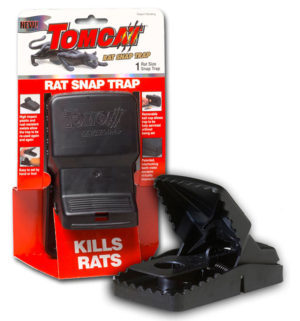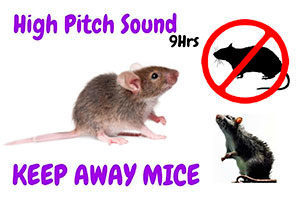You have discovered mice droppings in your cupboards. Food is spilling out of packages in your pantry because holes have been nibbled in them. You’re catching whiffs of an unpleasant odor. Its obvious mice have come to live with you. As far as guests are concerned, these are definitely the unwanted kind, and you want them gone. You know there are different kinds of mice. How can you tell which kind is in your home? The odor is stronger in the upper rooms and attic. Do the mice sleep there and travel to your kitchen at night to eat? Or do you have more than one kind of mouse setting up housekeeping in your home? Keep reading for answers to your questions.
[toc heading_levels=”2″]
There Are Dozens of Different Kinds of Mice
Many kinds of small rodents are commonly called mice. Some people identify the different kinds of mice by their coloring.
The common colors by which they name mice are:
- Black,
- Brown,
- Grey.

The fact that mice can be more than one color in the same species makes coloring less than accurate for identification.
It’s Hard to Distinguish One Mouse Species From Another
Other people look at behavior and distinguish one kind of mouse from another that way. Some mice eat as soon as they find food. Others store their food. While not fool safe, mice behavior is a more reliable method of identification than color.
As it happens, mice are opportunistic eaters. They have their preferences, and when food is abundant, they are herbivores. But a hungry mouse will eat anything it can find. When they’re in your home, you generally only know they’ve been in your food, and not necessarily which kind of mouse has invaded.
Two Kinds of Mice Like to Live in Your Home
Of all the different kinds of mice, you’ll commonly only find one of two kinds of dining in your home.
These are:
- House mouse,
- Deer mouse.
The third kind of mouse that you may find on your property is the field mouse.

Of these three, only the house mouse carries the scientific species name of Mus musculus. Other small rodents that look like mice are actually different species. All of them are pests that can carry disease and contamination into your home. You’ll find more facts about mice in this article.
Deer Mouse vs House Mouse: Which Is Which?
A deer mouse looks like a house mouse to many people, but there are differences. A house mouse is usually one color, although the color is lighter on their undersides than their topsides.
Deer mice are distinguished by white feet, legs, and undersides. Their tails are white on the underside. The hair on the rest of their body is often gray or brown. A deer mouse has larger eyes and ears than a house mouse has. It is also slightly larger, measuring about seven to nine inches from head to tail. A house mouse is about five inches from head to tail. Both have poor eyesight and rely heavily on their senses of smell and hearing to find food or evade predators.
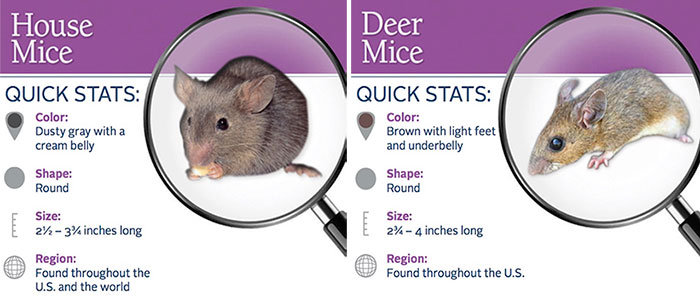
Deer mice prefer to live in rural areas rather in the urban areas that house mice prefer. However, both species are adaptable and can be found anywhere. A house mouse will eat food wherever it finds it. The deer mice are gatherers and store their food supply. Neither hibernates.
Mice Are Almost Everywhere
Mice are classified into six families, with more than 1,000 species. They have adapted over the ages to live everywhere there are humans, with the exception of Antarctica. Although mice do live in cold climates, they prefer warmth and seek shelter indoors.
Species of mice found throughout the United States include, but are not limited to:
- Cactus Mouse.
- Cotton Mouse.
- Harvest Mouse.
- Northern Pygmy Mouse.
- Plains Harvest Mouse.
- Salt-Marsh Harvest Mouse (on the endangered list and protected in California).
Every state has one or more species living in it. Some mice are so localized that they are named after their location, such as the California Pocket Mouse. Others are found nationwide. The mice are similar in appearance, but differ enough genetically to be individual species.
Will Deer Mice Invade My House?
Like any other species of mouse, a deer mouse will enter your home in search of food and shelter. They are adept at climbing. They can get inside by crawling up downspouts, trees, or vines to get into attics. They also like basements and crawl spaces. Deer mice build their nests in corners or inside unused furniture, boxes, or equipment.
 Deer mice like spacious living quarters. Their nests can be a foot or more in diameter. Outside, the nests are built with sticks, leaves, and other debris. Inside, mice construct their nests from whatever stuff of yours that they can shred.
Deer mice like spacious living quarters. Their nests can be a foot or more in diameter. Outside, the nests are built with sticks, leaves, and other debris. Inside, mice construct their nests from whatever stuff of yours that they can shred.
That includes, but isn’t limited to:
- Papers,
- Pieces of cloth,
- Insulation,
- Stuffing from your upholstered furniture.
Deer mice line their outside nests with fur or feathers; inside, they use the softest materials they can scrounge.
They Poop Where They Eat and Sleep
If a mouse infestation isn’t disgusting enough, deer mice use their nests as toilets. Within a few weeks, the nest becomes too nasty to inhabit. The female mouse then just builds a new nest nearby. You end up with a collection of foul-smelling abandoned nests. As these nests dry, they can become home to Hantavirus. If you’re removing nests, you must wear gloves and a mask. Avoid disturbing the nest enough to raise dust.
Which Kind of Mouse is in My House?
Mice are nocturnal, which makes them hard to find during daylight hours. You usually have to identify which kind you have by the signs they leave.
Three primary signs are:
- Droppings.
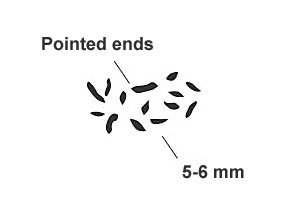
House Mouse Droppings - Kinds of foods eaten.
- Nests.
Knowing which kind of mouse is infesting your home is one of the keys to exterminating them.
Since deer mice defecate in their nests if you see a lot of droppings in drawers, cupboards, and other places where food is stored, the scales tip toward an infestation of house mice.
Another sign of house mice is the type of food being eaten.
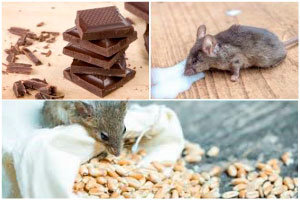 They prefer high fat and high protein foods, such as:
They prefer high fat and high protein foods, such as:
- Butter,
- Chocolate,
- Meat,
- Sweets.
You’ll see where they’ve nibbled on your food.
Deer mice prefer:
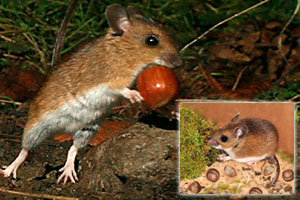 Fruit,
Fruit,- Greens,
- Insects,
- Nuts,
- Seeds.
Deer mice usually choose to gather food and store it to eat later rather than eating it where they find it.
The above lists and habits are their preferences. When hungry, any species of mice will eat whatever it can find, wherever it finds it. But if you discover caches of food, you more than likely have deer mice rather than house mice. What do mice eat? Read here.
A House Mouse Nest is Different From That of Deer Mouse
If you can locate a nest, you’ll have definitive evidence of which kind of mouse is keeping you company. As described above, the deer mouse builds large nests. A house mouse constructs much different looking nests. Their nest is much smaller, rarely more than six inches in diameter. The nest looks rather like an untidy ball or pile.
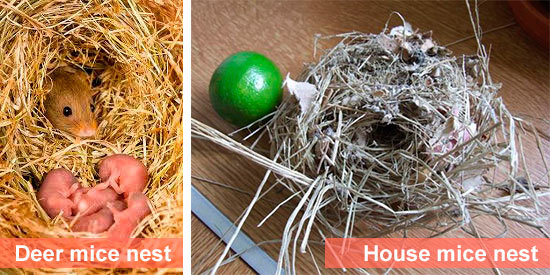
House mice use the same nesting materials as deer mice use. They build their nests between walls, beneath appliances, and inside or under furniture. All mice try to nest in hidden or dark spaces. They almost always construct their nests within 30 feet of their food supply. Both kinds give birth in their nests.
Neither species of mouse is clean. House mice aren’t quite as dirty as deer mice are. House mice usually defecate and urinate outside the nest, rather than inside it as deer mice do.
What Does a House Mouse Look Like?

House mice can be brown, gray, or black. Brown predominates. Their hair is short. They do have hair on their ears and tails, but it is so short and fine that they appear hairless in those areas. They have round “Mickey Mouse” ears and beady eyes. House mice have pointed snouts. Their tails are as long as their bodies. An adult house mouse rarely weighs more than an ounce.
Although house mice can be mistaken for baby rats, there are distinctive differences. The head of baby rats is wedge-shaped rather than pointed. Their tails are also not as long as their bodies. Their feces is differently shaped and sized. For more information on rats vs mice, read this article.
Some people like to keep a mouse as a pet. This isn’t a bad idea, as domestic mice can be playful and fun for kids. But when it comes to wild field mice, they aren’t nearly the same. The term “field mouse” can refer to many different species, but generally are the deer mouse or white-footed mouse. They’re small and can easily hide, and can be a true annoyance with the way they chew things up. Your electrical wires, furniture, yard – you name it. If you’re dealing with field mice, you’ll want an idea of how to get rid of them right away.
What Is the Difference Between a House Mouse and a Field Mouse?
Deer mice and house mice are the two different kinds of mice that you’ll find inside your home. There is another common kind of small rodent called a field mouse. Because house mice can live outside if they have to, they’re sometimes incorrectly called field mice.

Field mice are smaller than house mice. A field mouse has large eyes, rather than beady eyes.
Any kind of mouse in your home is a problem. They carry disease, contaminate your food, and destroy your belongings. Once you learn to identify which of the different kinds of mice have invaded your home, you can take steps to eliminate them. One way to keep all mice away is to seal any opening by which they can enter. Even the larger size mice can enter through openings as small as one-fourth inch. Once inside, you’ll need to use different techniques to evict your unwanted guests.
Facts About Field Mice
Something that’s interesting about these little rodents is that they’re similar to humans in the way their minds and bodies work, which is why they get used as test subjects in labs. Want to know more?
 Here’s some facts about field mice:
Here’s some facts about field mice:
- Female mice are called does.
- Males are called bucks.
- Baby mice are called pinkies, for their pink all-over color.
- Some mice are endangered, like the Alabama beach mouse.
- They can jump nearly 18 inches into the air.
- Field mice can communicate using regular sounds as well as ultrasonic sounds.
- Their heart can beat at 632 beats per minute.
- A mouse can be stung several times by a scorpion unharmed.
If you want to know more facts about mice, go here.
How big are they?
A field mouse can be as large as 7 inches or as small as a few inches, not including the length of the tail.
As for colors, most often they have white bellies with brown or gray backs. Some mice have tails that are as long as their entire body. In general, rats are bigger than mice.
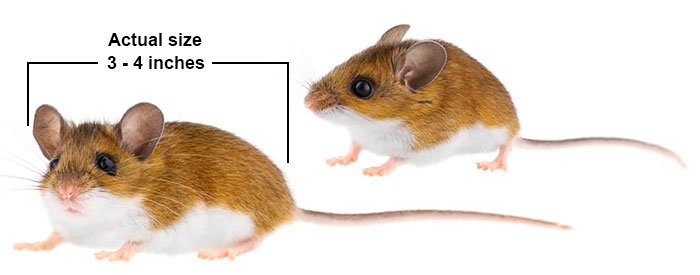
Is it a mouse, or is it a rat? Some people can’t seem to tell. If you want to know the difference between rats vs mice, click here.
Their lifespan might not be what you expect
A domesticated mouse pet you’ll get at a pet store can live for several years. As for a mouse in the wild, it’s different.
Usually, a field mouse has a lifespan ranging from 1 to 2.5 years. This shorter duration has to do with natural predators and a harsher environment than domesticated mice that live in a cage in a home.
How to identify one
You’ll recognize a field mouse by its large, dark eyes, and thin, big ears. Their tail is as long as their body. You’ll find them mostly in a grassy field, but sometimes they’ll be in your house if there are easy entrance and exit.
The diet of a field mouse
Unlike you’ll see in comics or movies, mice don’t have a diet made of cheese. In fact, that’s pretty low on their list when it comes to food. What makes up a field mouse’s diet?
- Seeds,
- Fruit,
- Plants,
- Snails,
- Insects,
- Animal remains,
- Meat.
No, mice don’t only eat cheese. In fact, they’ve got a bigger diet than you think. So, what do field mice eat? Go here to find out.
Where do field mice live?
The name “Field Mouse” is in place for a reason, as they like to live in fields where food sources are plentiful. But you’ll also find them in forested areas, and countrysides.
A field mouse can also get into your house, either for food or warmth when the weather begins to get colder. They’ll usually be made a home inside your walls where you can’t see them, underneath your house, or in the garage.

Behaviors
A field mouse has certain characteristics about them that will distinguish them from many other animals. Not just the way they look, although their cartoonish eyes and huge ears do make them distinctive.
Activity
Field mice are mobile and active at night, meaning that they’re mainly nocturnal creatures. During the day, they’ll hide in their burrow and sleep the day away until ready to come out again. Because of this, they make excellent prey for other nocturnal hunters, like owls.
Reproduction
Female field mice can begin to breed at only 35 days old and have litters of about 5 to 6 babies each. Breeding occurs most commonly between March and October, and each female can give birth to 2 to 4 litters each year.

Don’t try and capture a field mouse for a pet. Not only are they not as friendly as store-bought mice, but they are also notorious for carrying diseases that they can transmit to you in a bite or excrement. They might not live as long as you’d think, either, since they’re a natural way to live is out in the wild and not in a cage.
Because of how short and frequent the reproduction cycle is, a field mice population can grow out of control fairly quickly. If some decide to make your area home, you could face an infestation sooner than you think.
They’re social
Mice are surprisingly social creatures. They’ll live in burrows together with other field mice, communicating everything from reproduction, aggression, friendship, and even sadness. Researchers have found that a female and male mouse go best together, while a male mouse doesn’t do well alone with another male. Two females, on the other hand, seem to get along just fine.
A field mouse isn’t the only type there is. There are actually many different types of mice out there you’ll probably see. More details on different kinds of mice can be found here.
What to Do When You’ve Got an Infestation
There are three reasons you’ll want to do something about a field mouse infestation:
- Protect your possessions: Mice will gnaw and chew on many household items like electrical wiring, couches, rugs, and clothing. This isn’t because they’re eating it; it’s actually because they’re using the pieces they chew off to build a nest.
- Disease: Mice carry disease. Hantavirus, Lyme disease, and Salmonella are all illnesses that are carried by rodents like field mice.
- Food: Field mice will be able to tell where your kitchen is and will head to it to forage for food while you sleep. If they get into your pantry, you’ll have to throw away any food they’ve touched which can be expensive – and make sure you throw it out, as mice can contaminate your food with the above-mentioned diseases.
You can get rid of field mice by plugging up any holes they’re getting into your house through, or by extermination methods like traps. There are also poisons you can buy that are effective and kill any mice that might invade your home.
Mouse droppings everywhere
A sure-fire way to tell if you’ve got a field mouse problem is by their droppings. These mice have droppings with pointed ends that are black or brown and about ¼ inch long. It is mostly by a field mouse’s droppings that a disease will be spread, whether it’s in food or on a prep surface. If you don’t clean up mouse droppings on your surfaces properly, disease can stay on that surface and be transmitted to you.
 Here’s how to make sure any surface contaminated by a mouse stays sanitary:
Here’s how to make sure any surface contaminated by a mouse stays sanitary:
- Use a paper towel to pick up any droppings you see and put them into a small trash bag, then bring that bag out to the outside garbage can.
- Use a strong anti-bacterial and anti-viral cleaning solution to scrub the surface for at least one minute. Rinse with water.
- Place any used towels directly into the washing machine, and throw away any paper towels into the garbage right away.
- Thoroughly wash your hands with anti-bacterial soap.
Along with droppings, field mouse urine can also carry disease. If you touch any, do not touch your eyes, mouth, or nose until you wash your hands thoroughly with soap and warm water.
If you notice a field mice problem on your property, make sure you take action before their population quickly grows out of control. Not only it is better for your health, but it can also save your possessions, and give you some peace of mind that there aren’t little rodents running your household while you sleep.
